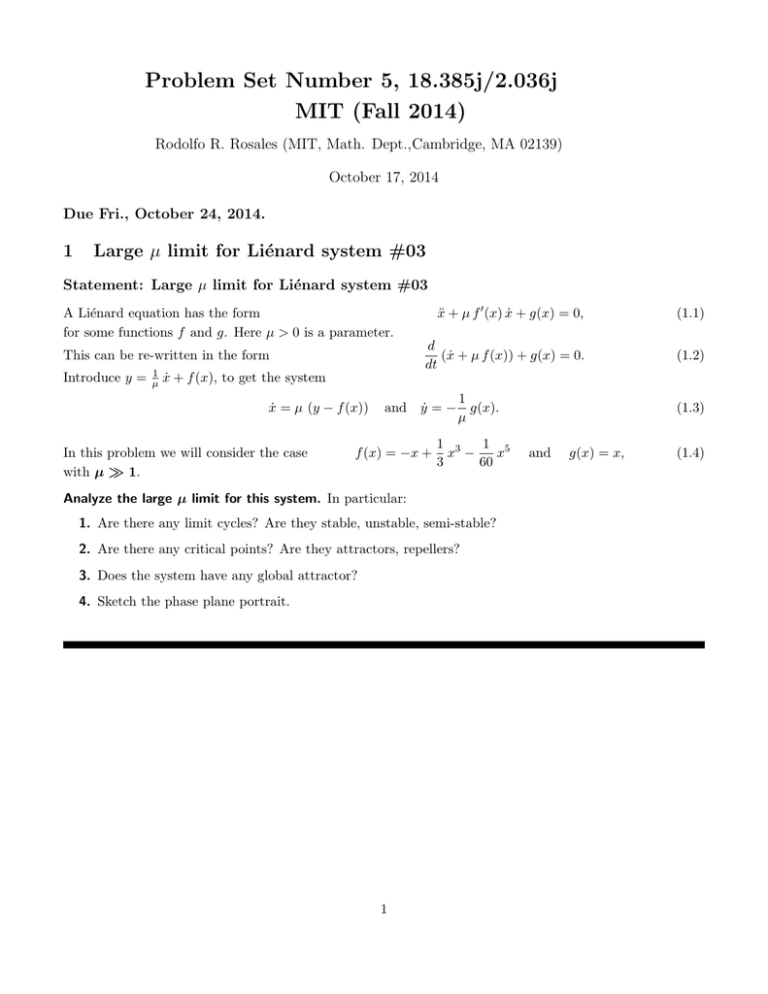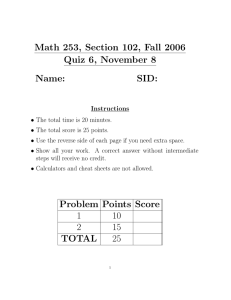Problem Set Number 5, 18.385j/2.036j MIT (Fall 2014) 1
advertisement

Problem Set Number 5, 18.385j/2.036j MIT (Fall 2014) Rodolfo R. Rosales (MIT, Math. Dept.,Cambridge, MA 02139) October 17, 2014 Due Fri., October 24, 2014. 1 Large µ limit for Liénard system #03 Statement: Large µ limit for Liénard system #03 ẍ + µ f 0 (x) ẋ + g(x) = 0, (1.1) d (ẋ + µ f (x)) + g(x) = 0. dt (1.2) A Liénard equation has the form for some functions f and g. Here µ > 0 is a parameter. This can be re-written in the form Introduce y = 1 µ x˙ + f (x), to get the system ẋ = µ (y − f (x)) In this problem we will consider the case with µ 1. 1 and ẏ = − g(x). µ f (x) = −x + 1 3 1 5 x − x 3 60 Analyze the large µ limit for this system. In particular: 1. Are there any limit cycles? Are they stable, unstable, semi-stable? 2. Are there any critical points? Are they attractors, repellers? 3. Does the system have any global attractor? 4. Sketch the phase plane portrait. 1 (1.3) and g(x) = x, (1.4) 2 2 Saddles and Conservative Systems Statement: Saddles and Conservative Systems Saddles for conservative systems are special, with the rate of expansion and contraction along the two principal directions equal. The purpose of this problem is to show this. Consider a phase plane autonomous system dx = f (x, y) dt and dy = g(x, y), dt (2.1) where both f and g have continuous partial derivatives. We will now assume: A. The origin x = y = 0 is an isolated critical point; in fact: a saddle, with eigenvalues for the linearized problem λ1 > 0 > λ2 . B. The system is conservative near the origin. That is: there is a function E = E(x, y) (defined in a neighborhood of the origin) which is a constant on the orbits. Furthermore, assume that E is twice continuously differentiable, and that ∇E 6= 0 (except at the origin). C. The origin is a true saddle for E — that is det(D 2 E) < 0 at the origin. Show that: λ1 = −λ2 — which is equivalent to fx (0, 0) + gy (0, 0) = 0 (why?). Remark 2.0.1 What does C mean? Since E is twice differentiable we can write E = E0 + 1 1 a x2 + b x y + c y 2 + o (x2 + y 2 )1.5 , 2 2 (2.2) where E0 , a, b, and c are constants. Then det(D2 E) < 0 ⇐⇒ a c − b2 < 0 — which means that the quadratic form Q = Q(x, y) = 12 a x2 + b x y + 12 c y 2 above in (2.2) is non-degenerate and non-definite. Thus: 1. The level lines for Q govern the local behavior of the level lines for E, and 2. Q has a saddle at the origin, so its level lines yield a saddle. Hence the surface z = E(x, y) has a saddle at the origin, dominated by the quadratic terms in its Taylor expansion. Example where this is not true: Consider the system ẋ = x and ẏ = −2 y, which has a saddle at the origin, and the conserved quantity E = y x2 . But the surface z = E(x, y) does not have a saddle at the origin.1 Another example is provided by the system ẋ = x and ẏ = −3 y, also with a saddle at the origin and a conserved quantity: E = y x3 . In this case the surface z = E(x, y) has a saddle at the origin, but it is a very degenerate saddle.2 Remark 2.0.2 Note concerning ∇E. From equation (2.2) is follows that ! ! ! ax + by a b x ∇E = + o (x2 + y 2 ) = + o (x2 + y 2 ). bx + cy b c y (2.3) Thus, because the matrix of coefficients is non-degenerate, ∇E = 6 0 near (but not at) the origin. 1 By “saddle” we mean that the level lines E = 0 split the plane into four regions, and in each region E grows (decays) as we move away from the origin, with decay and growth alternating. 2 You would not like sitting on a horse saddle made following this design! 3 Hint 2.0.1 Because E is conserved: Z = Z(x, y) = f Ex + g Ey ≡ 0. Explain why this. (2.4) On the other hand, because f and g are differentiable (and the origin is a critical point), we can write (for some constants α, β, γ, and δ): f = α x + β y + o (x2 + y 2 ) and g = γ x + δ y + o (x2 + y 2 ). (2.5) Substitute these expansions — and (2.3), into (2.4) and conclude that 0 = α + δ = fx (0, 0) + gy (0, 0). This then implies λ1 = −λ2 (why?), which is precisely what you are being asked to show. Remark 2.0.3 General saddles. Modulo a nonsingular linear transformation of the dependent variables x and y, and a change in the time scale (possibly including a time reversal), the equations for a linear system with a saddle can ẋ = −x and ẏ = ν y, where ν ≥ 1. (2.6) always be written in the form Conserved quantities for this last system must have the form E = f (|x|ν y), where f = f (ζ) is some arbitrary function. But then Ex = sign(x) x(ν−1) y f 0 (|x|ν y) and Ey = xν f 0 (|x|ν y), (2.7) so that ∇E vanishes identically for x = 0, unless ν = 1, which corresponds to λ1 = −λ2 . 3 Uniqueness of the van der Pol oscillator limit cycle Statement: Uniqueness of the van der Pol oscillator limit cycle Consider the van der Pol equation d2 x dx + µ (x2 − 1) + x = 0, 2 dt dt where µ 6= 0 is a constant. Show that (3.1) has a unique limit cycle. (3.1) The existence of, at least one, non-trivial 3 periodic orbit was shown in class. Hence, you need only show that there cannot be more than one such orbit. It follows (Poincaré-Bendixon theorem) that the limit cycle is a global attractor (repeller) for µ > 0 (µ < 0, resp.). Only one orbit (the critical point) does not approach the limit cycle as either t → ±∞. Hints. h1. Index theory tells us that periodic orbits must enclose the (single) critical point x = ẋ = 0 in the phase plane (x, y) — where y = ẋ. Hence, if the number of periodic orbits exceeds one, they will be nested. Any two successive ones will then delimit an annular region Ω, with the origin in the center hole. h2. The change t → −t reverses the sign of µ in (3.1). Hence, without loss of generality, assume µ < 0, and write dx dy the equation as = y and = −x − (1 − x2 ) y, where = −µ > 0. (3.2) dt dt Then the origin is an attractor (node or spiral, depending on the size of ), and the limit cycle is unstable. 3 Note that critical points are (trivial) periodic orbits. 4 h3. Study the behavior of the function E = 1 2 x2 + y 2 along the solutions to (3.2), and show that: If (x, y) = (X(t), Y (t)) is a non-trivial periodic solution, then X 2 + Y 2 > 1 for all t. Thus the center hole for the item h.1 annular region Ω includes the unit disk x2 + y 2 ≤ 1. (3.3) To prove (3.3) you need to examine the sign of Ė in the unit disk. Be careful to provide a complete proof for (3.3), since along the segment y = 0 and −1 ≤ x ≤ 1 (where E˙ = 0) a special argument is needed. p h3. Find a function g = g(r), defined and smooth for r = x2 + y 2 > 1, such that h i I = div (ẋ g, ẏ g) ẋ and ẏ as given by (3.2) (3.4) is non-negative for r > 1, and vanishes for x = ±1 only. Note that g could have singularities when r ≤ 1 — we do not care about what happens there. Sub-hint. The expression for I in (3.4) involves g and its derivative g 0 . The trick is to pick g 0 in terms of g and r so that the desired property applies. This will give you an ode for g, which you can solve. h4. Generalize Dulac’s criterion to prove that there can be only one periodic orbit: (1) Assume that there is more than one periodic orbit, and consider the region Ω between any two consecutive ones, as defined in item h.1. (2) Integrate I, defined in (3.4), over Ω. Use Gauss theorem to reduce the integral to an integral over the boundary of Ω, which is made up by the two periodic orbits. This should yield a contradiction. It follows that the assumption in (1) must be false: there cannot be more than one periodic orbit. THE END. MIT OpenCourseWare http://ocw.mit.edu 18.385J / 2.036J Nonlinear Dynamics and Chaos Fall 2014 For information about citing these materials or our Terms of Use, visit: http://ocw.mit.edu/terms.



